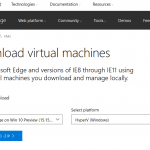Microsoft Virtual Server 2005 R2 provides a virtualization platform that runs most major x86 operating systems, including Linux in a separated environment. Virtual Server 2005 R2’s comprehensive COM API, in combination with the Virtual Hard Drive (VHD) format and support for virtual networking and hypervisor, provide administrators complete scripted control of portable, connected virtual machines and enable easy automation of deployment, and ongoing change and configuration.
Microsoft has made Microsoft Virtual Server 2005 R2 Enterprise Edition a free download, which previously been sold for a fee. The Virtual Server 2005 has a few new functionality including virtual Server host clustering, iSCSI support, x64 support, enhanced PXE booting, improved hyper-threading, support for F6 Disk (SCSI driver), and virtual disk pre-compactor functionality, beside improvement in performance.
For more information on Microsoft Virtual Server 2005 R2 Enterprise Edition, visit here, and download the virtual server here for free.
Note: Virtual Server 2005 R2 Enterprise Edition has been superseded by Microsoft Virtual Server 2005 R2 SP1.





